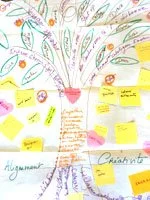find your identity, clarity & direction by Drawing your Tree of Life
reflect on your past, acknowledge who you are today and project yourself into the future
The purpose of this exercise is to reflect on what’s made you who you are, think about what you are doing now and explore what you want to do in the future. It’s particularly useful for young people who are trying to find their path in life, but also for adults who feel stuck, unhappy with their personal or professional circumstances, and for couples who want to restore a strong bond. It will give you a structured process to help you reflect and visualise, and you’ll come away with a clearer sense of your identity and direction in life.
Where it comes from:
The Tree of Life is a storytelling approach to counselling initially developed by Ncazelo Ncube-Mlilo in collaboration with David Denborough to support children affected by HIV and AIDS. The methodology is now used in mental health and psychosocial services in different parts of the world. It helps people talk about the stories of their lives in ways that make them stronger. It focuses on the second stories of people’s lives (good and positive stories) which give people hope and encouragement and support them to tackle the problems of life. (1)
The exercise can also be found in the book Retelling the Stories of Our Lives: Everyday Narrative Therapy to Draw Inspiration and Transform Experience by David Denborough.
What you need to draw your tree of life:
Download the worksheet to help you clarify what you want to write on your tree of life before you draw it.
A big piece of paper - at least A3 or flipchart paper (you could tape together a few A4 sheets). I started doing it on an A4 sheet and very quickly ran out of space.
Colouring pens or pencils - at least 7 colours so that the different elements of your tree stand out.
Quiet and undisturbed time - at least 1 hour to get a good draft. But you might need more time if you want to dive deeper or if you want to re-draw the final version.
A comfortable place to draw and write.
Anything else that will make this experience enjoyable: a candle, a fire, music, a drink
How to draw your tree of life:
Start by drawing a tree with the roots, grass and branches. Keep the drawing minimal at first, as the words that you will write are more important. You can always start with a draft version and then draw it again later.
1. The roots
Here’s a hand drawn tree of life that you can replicate. Artist: me :)
The roots of the tree represent the past. Write down where you come from by including places, people, cultures, activities and organisations that have shaped you in the past. You can also add elements of your family history, significant relationships, what you have studied and achievements that you are proud of.
2. The grass
The grass is the present. Write down where you live now and the activities that you choose to do and enjoy doing every day, week or month. Think about what gives you energy, what you need to do to keep growing. Don’t write things that you are forced to do and that you haven’t chosen.
3. The trunk
This part of the tree is about you and your uniqueness. Write here your values, strengths, skills and personality traits that define who you are and that you are proud of. This is actually quite a big part of the process and you might find it difficult to describe these. If that’s the case, check out my free workbook to help you know yourself better.
4. The branches
Branches represent the future. What are your hopes and dreams? In which direction do you want to take your life? Write here the vision and objectives you have for yourself, but also what you wish to see happen in your wider community and the world.
5. The leaves
The leaves are the people (and pets) that are significant to you, who support you and give you energy. It may be people that have passed away but still have had a strong impact on you. It can also be famous people that you admire and inspire you.
6. The fruits
The fruits are the gifts and legacies that you have received from others. Gifts can be material (e.g. money, inheritance, a house…). They can also be intangible, such as acts of kindness, memories, events that taught you something, the support you received or the impact someone had on you. Look at the significant people that you wrote on the leaves and think about what they gave you.
Optional elements to add to your tree of life:
Here are some additional elements that you can add to your drawing. Without being key to the exercise, they will add another layer of reflection.
Flowers
What are the gifts and legacies that you want to give others? What impact do you want to have? What support do you want to give?
Clouds
What are the obstacles, challenges, fears, worries, self-limiting beliefs that could get in the way of achieving your dreams and goals? Write these in the clouds that surround your Tree of Life, and think about what you have learned and know about yourself, that will enable you to tackle these blockers.
A compost bin
As work through your Tree of Life, you might come across negative events that you’d rather not remember. However, they are part of who you are. So put past traumas, bad relationships, negative events that you don’t want to be defined by in the compost bin.
A bird in the tree
Is there a song or a type of music that makes you happy, gives you energy?
Next steps:
When you’ve finished drawing your tree, you might find yourself facing a lot of thoughts and emotions, both positive and negative. That’s completely normal and you might need to speak to someone about it. Depending on the conversation and support you need, I’d recommend talking to a therapist, a coach or a friend.
Also, once you’ve done your draft with everything that you want to write, you could draw the final version of your tree on a bigger piece of paper, with more colours, so that you can put it up on a wall. Here are some examples I found online:
IF YOU WANT TO KNOW MORE ABOUT YOURSELF SO THAT YOU CAN CREATE THE LIFE THAT YOU WANT, I'VE DESIGNED A 6-MODULE ONLINE COURSE PACKED WITH SELF-REFLECTION EXERCISES THAT WILL INCREASE YOUR SELF-KNOWLEDGE AND SELF-CONFIDENCE.
Sources:
“The Tree of Life Project - Using narrative ideas in work with vulnerable children in Southern Africa” By Ncazelo Ncube, The International Journal of Narrative Therapy and Community Work, 2006 No 1.
https://nathanbweller.com/tree-life-simple-exercise-reclaiming-identity-direction-life-story/







